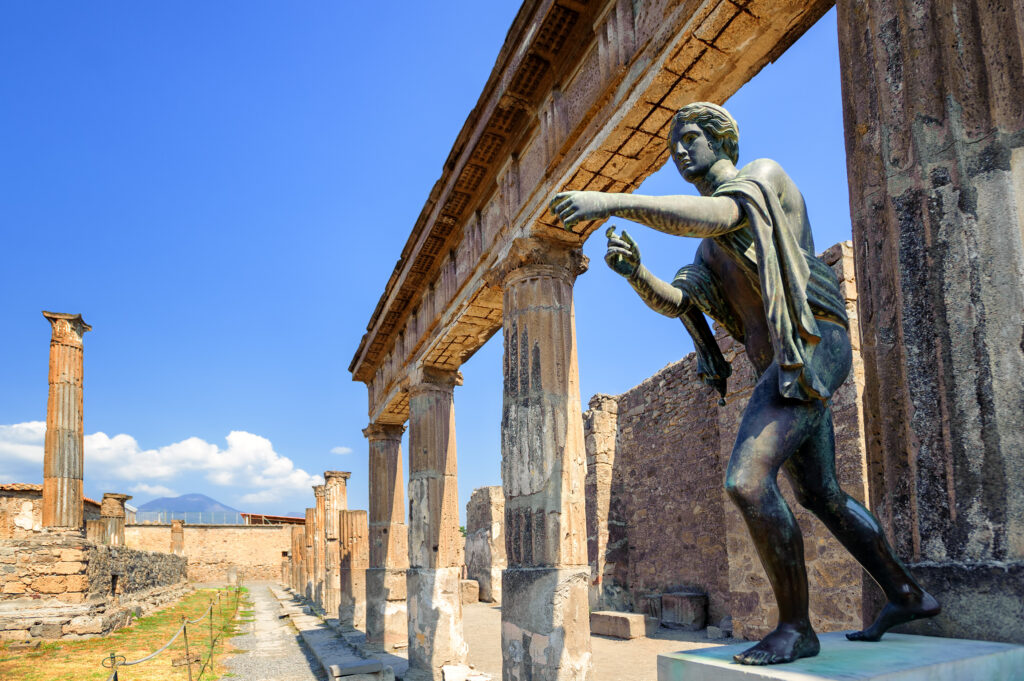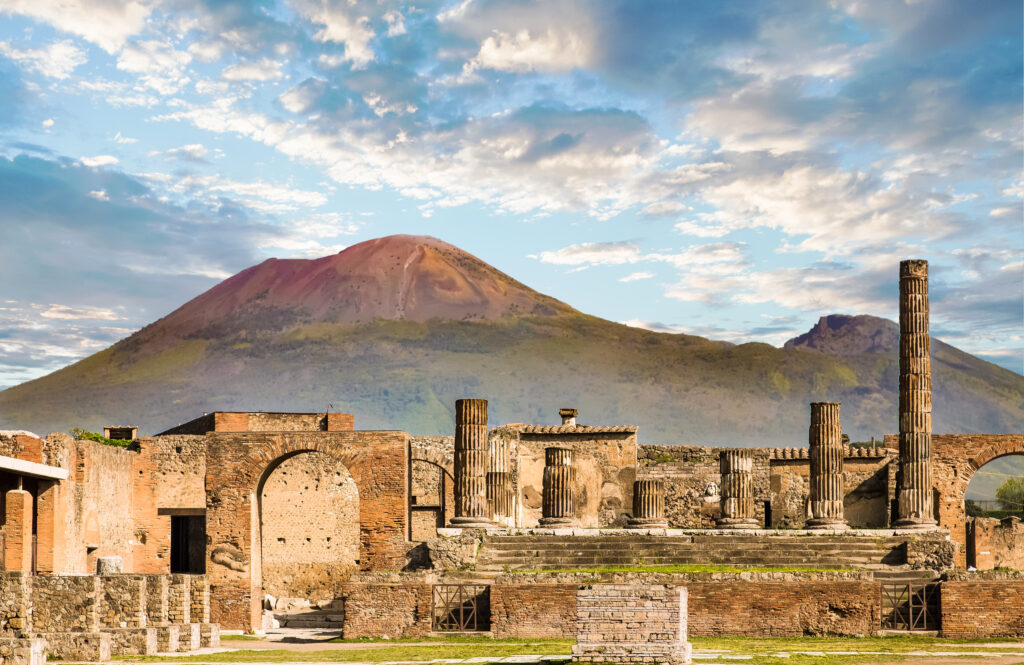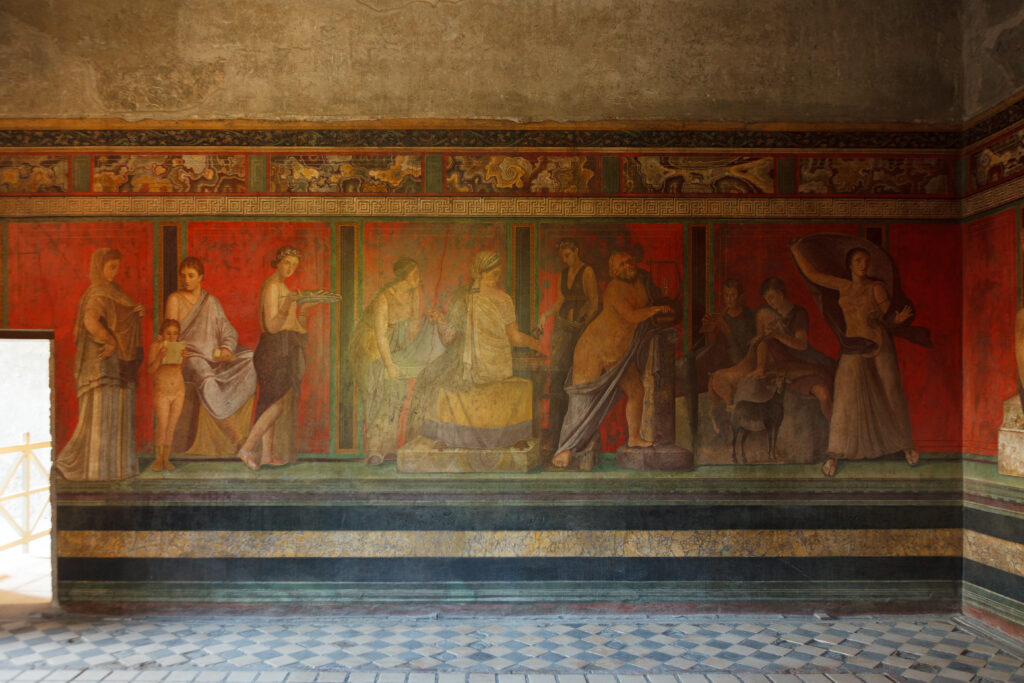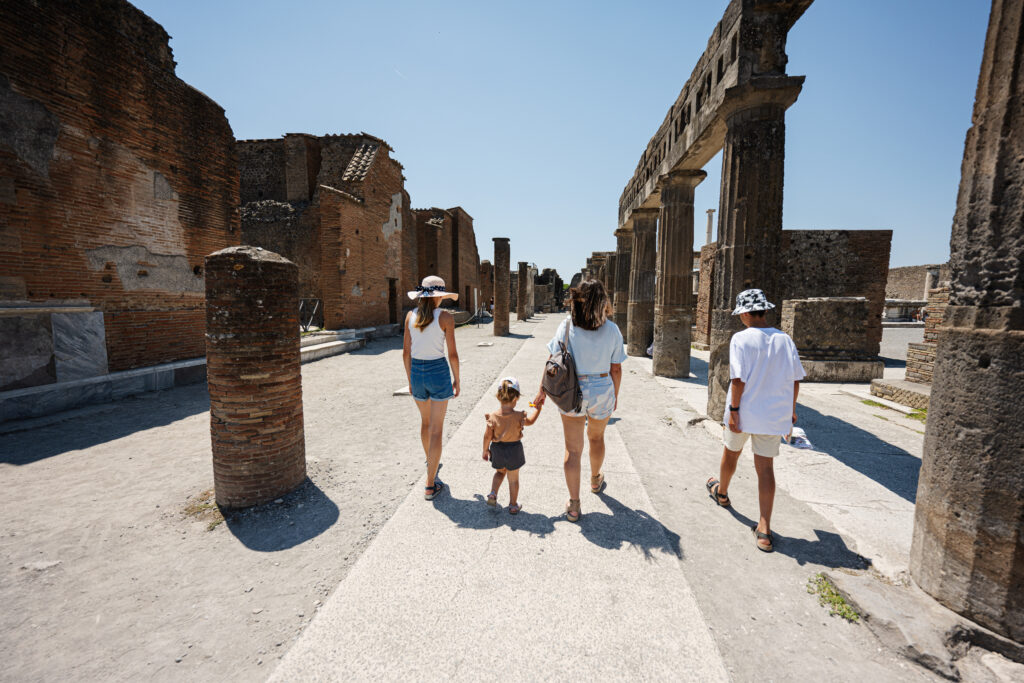
A visit to Pompeii is one of Italy's most visited sites, and undoubtedly one of the most fascinating. It all began in 79BC, when Vesuvius, still one of the world's most active volcanoes, erupted. Its lava, and above all its ashes, buried the Roman village of Pompeii and Herculaneum forever.
The story might have ended there, had the remains of the Roman village not been discovered by chance during a construction project in the 17th century. Perfectly preserved, it is one of the most fascinating testimonies to Roman life: objects, roads, mosaics, frescoes, traces of horse-drawn carriages and even bodies frozen forever.
How do I get to Pompeii from Naples?

Pompeii is one of Naples' must-sees, so the municipality provides transportation to get you there. There are several options:
- By train: this is the most popular option, thanks to the Circumvesuviana towards Sorrento, which circles Vesuvius and will drop you off at the Pompeii Scavi station in half an hour, for €3.10. In season, there's a departure every 20-30 minutes from Napoli Centrale station.
- By bus: from Garibaldi station, a SITA bus also takes you to Naples, stopping at Pompei Scavi. There's a bus every 30 to 60 minutes, for €2.60 a ticket. Flixbus also offers this service.
- With an agency: some agencies offer all-inclusive excursions from Naples, and pick up visitors at their hotel with a shuttle to accompany them on a guided tour of Pompeii.
- By car: simply drive south-east along the A3 freeway to the Pompeii Ovest exit. Allow half an hour for the journey.
What to see and do in Pompeii?

Most visitors don't realize just how vast Pompeii is! The site stretches over 66 hectares, so much so that it seems impossible to see everything. So you'll have to make your own choices, and put together your own itinerary.
Pompeii is divided into regions, numbered 1 to 9. You'll receive a map of the site on site. There are :
- Region I: home to many shops and villas, such as Casa del Menandro, one of Pompeii's largest, or Casa dell'Efebo.
- Region II: famous for its amphitheatre, one of the oldest in the world.
- Regions III, IV and V: these areas are still mostly buried, with excavations still to be carried out.
- Region VI: or aristocratic region, home to luxurious villas such as the Casa del Fauno and the Villa dei Misteri, superbly decorated with frescoes.
- Region VII: home to numerous public buildings, such as the Stabiane thermal baths, the oldest of the city's 5 thermal baths, dating back to the 3rd century, and the Foro, or Forum, with its view of Mount Vesuvius, one of the city's must-sees.
- Region VIII: this zone includes many sacred buildings such as temples and basilicas.
- Region IX: this area is the subject of very recent excavations, and is being revealed a little more each day.
The most interesting regions are I, II, VI, VII and VIII. What's more, they all follow each other in an L-shape, so you can put together your own itinerary according to your interests and time available.
We've put together a complete one-day itinerary that will allow you to visit Pompeii and admire the main sites of interest:
- Enter from the Piazza Anfiteatro in Region II, to the east, where gladiators fought.
- In Region II, walk from the Palestra Grande, a sports ground, to the Casa della Venere in Conchiglia, a villa housing Pompeii's most famous fresco, depicting Venus in her shell, very well preserved.
- Reach Region I via Via dell'Abbondanza, one of the city's main thoroughfares, which leads to the Thermopolium di Asellina, on the edge of Region IX. This is Pompeii's finest thermopolium, a Roman fast-food restaurant!
- Continue intoRegion I, admiring the Casa dell'Efebo, then the Casa del Menandro.
- Return to Via dell'Abbondanza and head for Region VIII, where you'll admire, in order, the Temple of Isis, dedicated to the Egyptian goddess, the Teatro Piccolo - Odeion, which could seat 1,000 spectators, then the Teatro Grande, which could seat 5,000 spectators, and finally the Caserma dei Gladiatori, or gladiator barracks.
- Then move on to Region VII, where you'll discover the superbly preserved Stabiane baths, followed by the Lupanare, the finest of Pompeii's 25 brothels, with 5 guest rooms decorated with evocative frescoes. Then walk west towards the Forum, Pompeii's main public square, bordered by the Temple of Apollo. Then head north, visiting the Terme del Foro thermal baths.
- Enter Area 6, the city's wealthiest district, visiting first the casa del Poeta Tragico, famous for its mosaic warning of the presence of a dog, then head for the casa del Fauno, one of Pompeii's largest villas, famous not least for its mosaic depicting Alexander the Great.
- Then head back down to the piazza Esedra.
What are the different options for visiting Pompeii?

There are several options for visiting Pompeii:
- Entrance ticket: for a self-guided tour. There's always a long queue at the ticket office as soon as it opens, so it' s more sensible to buy your ticket in advance online right here !
- The audioguide tour: on site, these are only available at the main entrance, porta Marina, for an additional fee. They allow you to visit Pompeii on your own, but still benefit from enlightened commentary. You can also book them online here .
- The guided tour: the visit will be commented by a professional guide or archaeologist, and generally lasts 2 h, perfect if you're only staying a short time in Naples, but you can stay on your own afterwards. You can book your guided tour online before your visit right here or at the ticket office, subject to availability.
- Packages: offered by tourist agencies, these allow you to group several visits together: Pompeii, Vesuvius, guided tour of Naples, transport... The packages are very varied, butthe most common is the guided tour of Pompeii + Vesuvius + transport, which you can book online right here!
Practical information you need to know before visiting Pompeii
Follow these tips to make sure you visit Pompeii in style.
When is the best time to visit Pompeii?
The site is very busy in the high season, fromApril to October, as well as during school vacations. So it's best to visit in low season, such as spring, winter or autumn, for greater peace and quiet.
How long does it take to visit Pompeii?
Dedicate an entire day to visiting Pompeii. Half a day or just a few hours is not enough. You're visiting an entire city!
What are the opening hours at the Pompeii archaeological site?
Opening times are divided between high and low season, with closures on January 1, May 1 and December 25:
- November1 to March 31: open from 9 a.m. to 5 p.m., last entry at 3:30 p.m.
- April 1 to October 31: open from 9 a.m. to 7 p.m., last admission at 5:30 p.m.
What equipment do I need to visit Pompeii?
During the day, you'll be doing a lot of walking, and the ground is not always even. So it's a good idea to bring hiking boots. Avoid sandals, as your feet will quickly get soggy. You'll also need sun cream and a cap to prevent sunstroke.
Take something to eat too. There's only one snack bar on site, at the forum, which can be inconvenient if you're at the other end when you get hungry, so it's best to pack a picnic. A single flask will suffice, as you'll have plenty to fill it on site. Pompeii has many fountains, just as it did in Roman times!
Make sure you don 't take a backpack that's too big, otherwise you'll have to leave it at the left luggage office. Bags larger than 30 x 30 x 15 cm are not allowed on site, but lockers are available.
What to do around Pompeii
The area around Pompeii is rich in discoveries and experiences:
- Herculaneum: Pompeii's twin, where you can extend your exploration.
- Vesuvius: you can climb Vesuvius, one of the world's most active volcanoes.
- Visit Naples: Naples is the beating heart of Italy, bubbling with energy.
- Discover the Amalfi Coast: one of Italy's most famous postcards.


